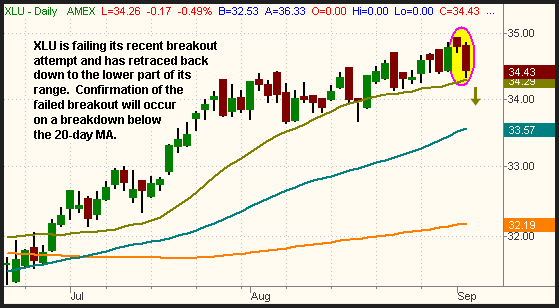Traders kicked off the holiday-shortened week on a positive note, as buyers focused on the semiconductor and other tech-related sectors. The small-cap Russell 2000 Index showed the most relative strength by advancing 0.8%, while the Nasdaq Composite trailed closely behind with a 0.6% gain. The bulls largely ignored the blue chips, causing the Dow Jones Industrial Average to finish unchanged. The S&P 500 gained 0.2% and the S&P Midcap 400 rallied 0.4%. As anticipated, strength in spot gold enabled the StreetTRACKS Gold Trust (GLD) to gain 2.0% and break out above its resistance that we illustrated in yesterday's newsletter. We bought GLD after it gapped up and traded above its high of the first twenty minutes.
Not surprisingly, volume surged higher across the board. Total volume in the NYSE increased by 20%, while volume in the Nasdaq was 30% higher than the previous day's level. This, of course, was indicative of traders beginning the return back to their desks after the traditional annual holiday season. The higher turnover enabled the Nasdaq volume to exceed its 50-day average level for the first time since August 17, but the NYSE volume remained below average. Technically, the gains on higher volume enabled both the S&P and Nasdaq to register bullish "accumulation days," but we were a bit concerned about the minimal gain in the S&P and the unchanged Dow. It appears that a bit of "churning," the sign of institutional selling into strength, was taking place. Considering a 20% rise in NYSE turnover, the percentage gains in the S&P and Dow should have been greater. Market internals also lacked conviction. In both exchanges, advancing volume exceeded declining volume by only 1.6 to 1. Typically, a healthy day of gains should correspond with a spread of at least 2 to 1, often much greater.
In addition to buying GLD yesterday, we also sold short the S&P Select Utilities SPDR (XLU). On August 31, XLU broke out to a new high from a multi-week base of consolidation. It gapped up the next morning, as one might expect, but the gap failed to hold. XLU finished unchanged that day. In yesterday's session, XLU exhibited major relative weakness by falling 1.1% while the broad market grinded higher. More importantly, the loss caused it to fully retrace all of the August 31 gain. We sold short XLU because the complete loss of the August 31 gain points to the telltale signs of a failed breakout. As we have mentioned in the past, failed breakouts have a high rate of success for short sellers because the traders who bought the breakout are forced to quickly sell their position, which in turn attracts the bears. Confirmation of the failed breakout will occur when XLU drops below its 20-day moving average, the brown line on the daily chart below:

There are several other ETFs tied to the Utilities sector as well. The Utilities HOLDR (UTH) is one of the most popular ETFs in the sector, but we prefer the more diverse S&P Select Utilities SPDR. When trading XLU, note that it has a very low Average True Range (ATR). This means that it is a low volatility ETF that may require larger than usual share size in order to realize a decent profit from a substantial move.
In determining share size for positions in our hedge fund, we make sure that our maximum capital risk is the same for every position. In order to do so, it is paramount to account for the different volatility in each position. A simple way to do so is by first determining how much room is required for your stop price, then taking that number and dividing it by your maximum capital risk per position. If, for example, you always risk $1,000 per trade and your trade requires a 2 point stop from the initial entry, your maximum share size would be 500 shares ($1,000 / 2 points = 500 shares). For XLU, the obvious stop placement is above the high of September 1. Giving the position enough room that the stop won't get triggered by a brief probe above the high, we determined that a stop of approximately 70 cents was required from yesterday's entry near the intraday low. If, however, you sold short UTH instead, a stop of more than 2 points is necessary for a corresponding entry point and stop price. Therefore, in order to keep both the risk and profit potential consistent in both trade setups, a position in XLU should be about three times the share size of a position in UTH. Constantly adjusting your share size to maintain a consistent maximum capital risk is one of the first steps towards developing a winning system in which the math simply works.
Deron Wagner is the Founder and Head Trader of both Morpheus Capital LP, a U.S. hedge fund, and Morpheus Trading Group, a trader education firm launched in 2001 that provides daily technical analysis of the leading ETFs and stocks. For a free trial to the full version of The Wagner Daily or to learn about Wagner's other services, visit MorpheusTrading.com or send an e-mail to deron@morpheustrading.com.